[ad_1]
To paint the Chand Baori stepwell of Jaipur in the traditional miniature style cannot be an easy thing to do. For Jaipur-based painter Rajnish Nimbark, to paint it upside down onto a semi-vaulted ceiling, was downright Escherian in complexity. “Even the trees were upside down,” he exclaims. Nimbark was tasked with bringing alive the walls and ceilings of the recently-opened Museum of Meenakari Heritage with frescoes depicting scenes of Indian festivals such as Diwali, Holi and patangbaazi (kite-fighting). “I’ve been doing this for 30 years, but I had never done that before.”
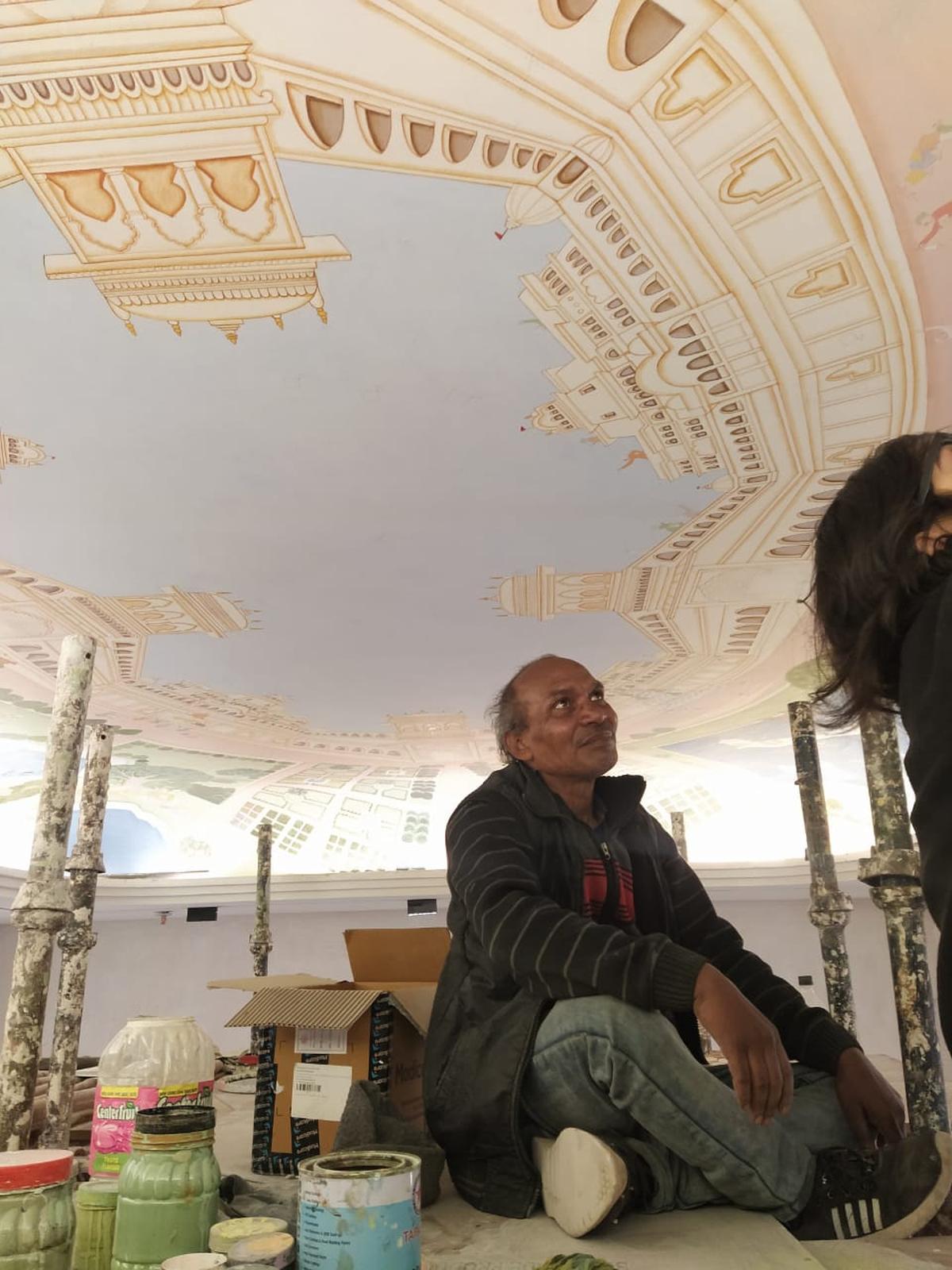
Artists painting the Chand Baori ceiling
\Over 1,800 km away, in Bhubaneshwar, Krushi Bhawan, the five-year-old office building for the state department of agriculture (and a pet project of chief minister Naveen Patnaik), boasts an equally distinct visual identity. One hundred artisans from Orissa wove farmland folklore and mythology into dhokra-style light fixtures, pattachitra-style carvings on laterite walls, and a brick facade inspired by ikat textile patterns. “We did not know we could do anything different,” says Sesha, one of the craftspeople in a promotional video. “Earlier, we did carvings for temples. It was only after this project that we realised our skills could be applied in other architectural projects.”
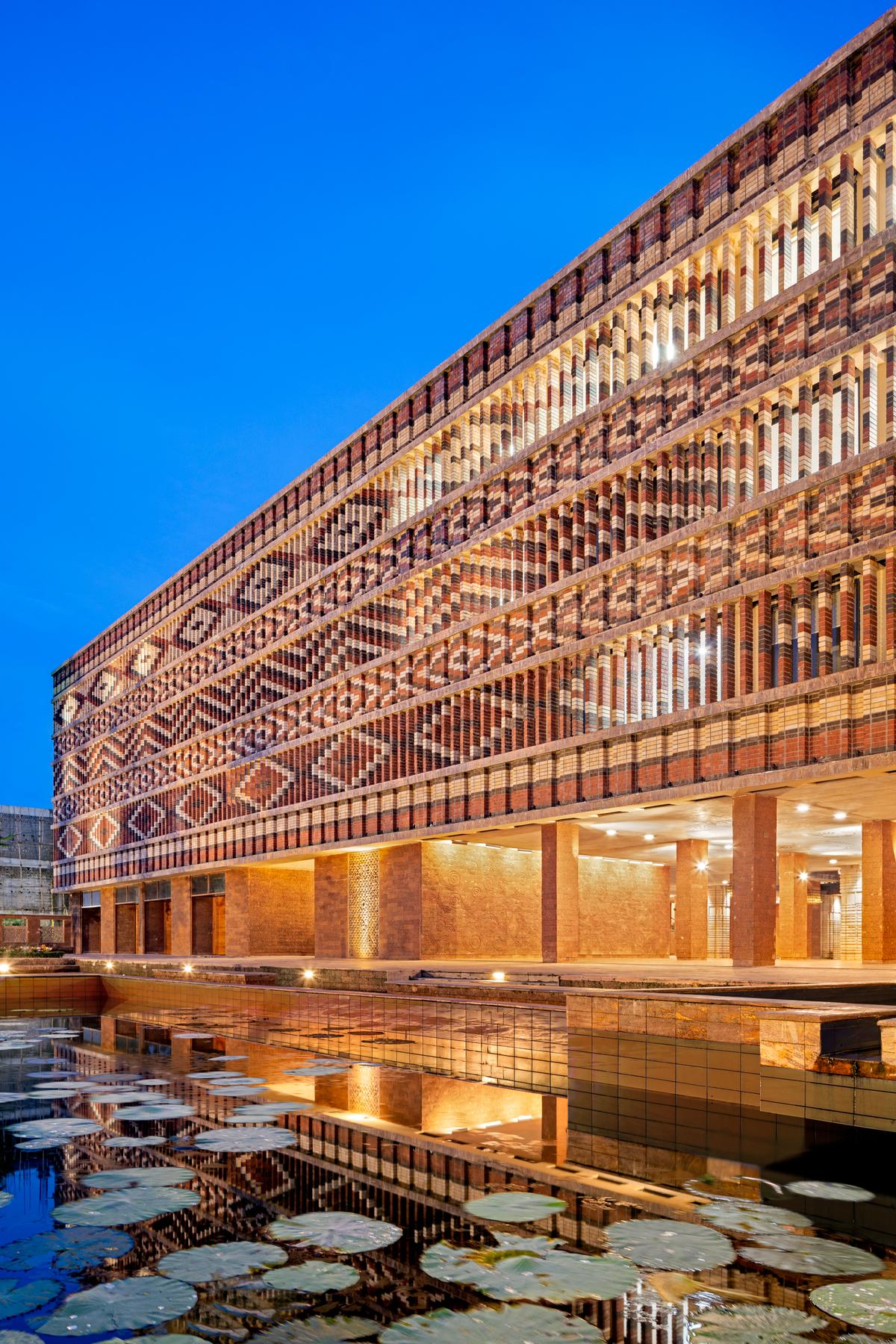
Krushi Bhawan
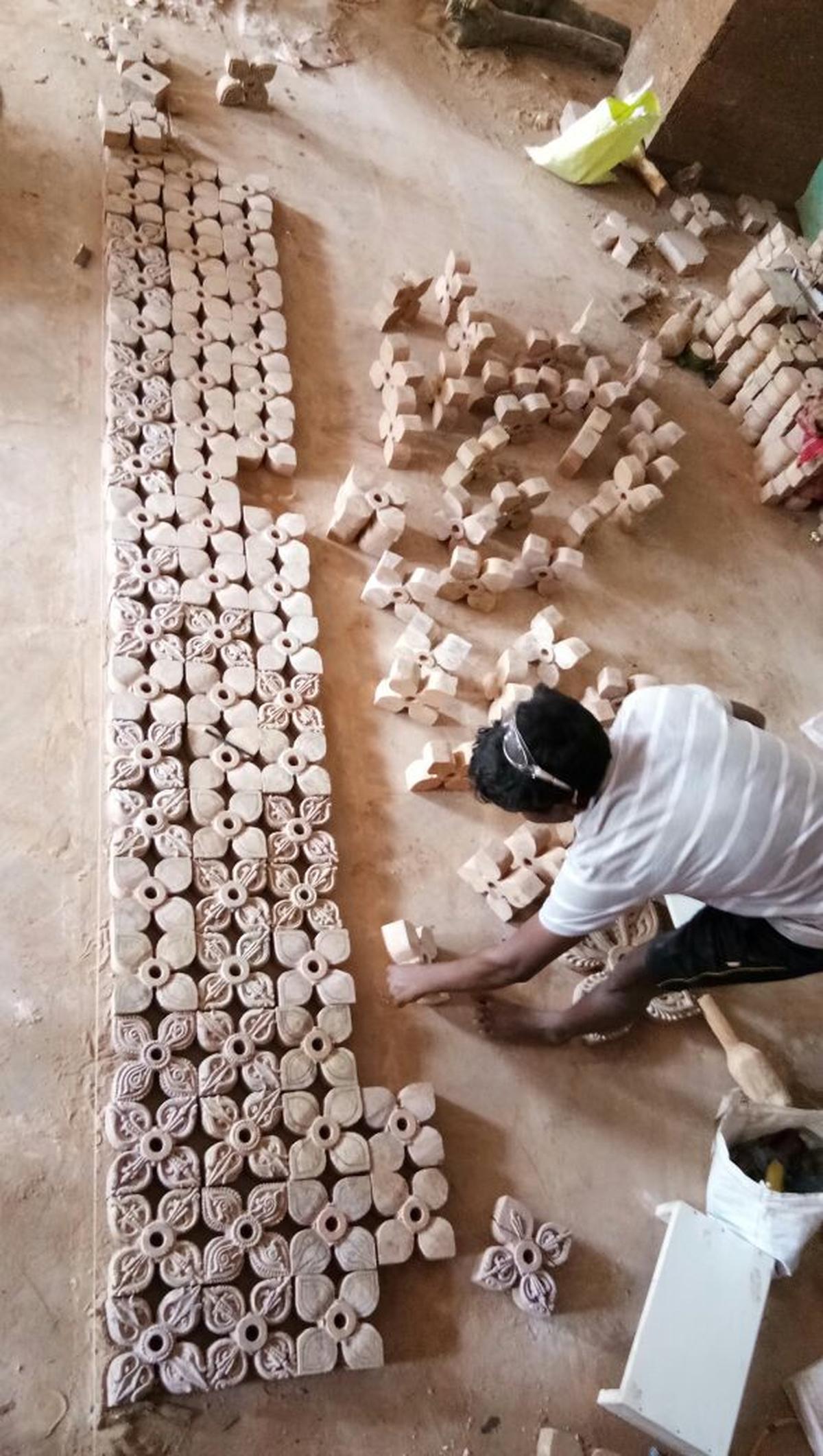
Craftspeople at work at the Krushi Bhawan
The idea for the frescoes came from Nisha Vikram, founder of CraftCanvas, an outfit that has been connecting craft communities focused on painting with urban customers since 2011, while Sibanand Bhol’s Collective Crafts, an organisation that drives innovation among artisan communities, worked with the Orissa craftspeople. Both are frequent collaborators of New Delhi-based design firm Studio Lotus, who spearheaded the two projects.
“What many don’t know is that [jewellery designer] Sunita Shekhawat was unhappy with the building that was originally constructed,” says Studio Lotus co-founder Ankur Choksi, talking about the flagship meenakari store and museum. “Instead of tearing it down, we suggested dressing it up inspired by the many architectural movements — Rajput, Mughal and Art Deco — seen in Jaipur and Jodhpur to give it a sense of place.” This is evident in the red sandstone facade, hand-carved jaalis and araish lime stucco.
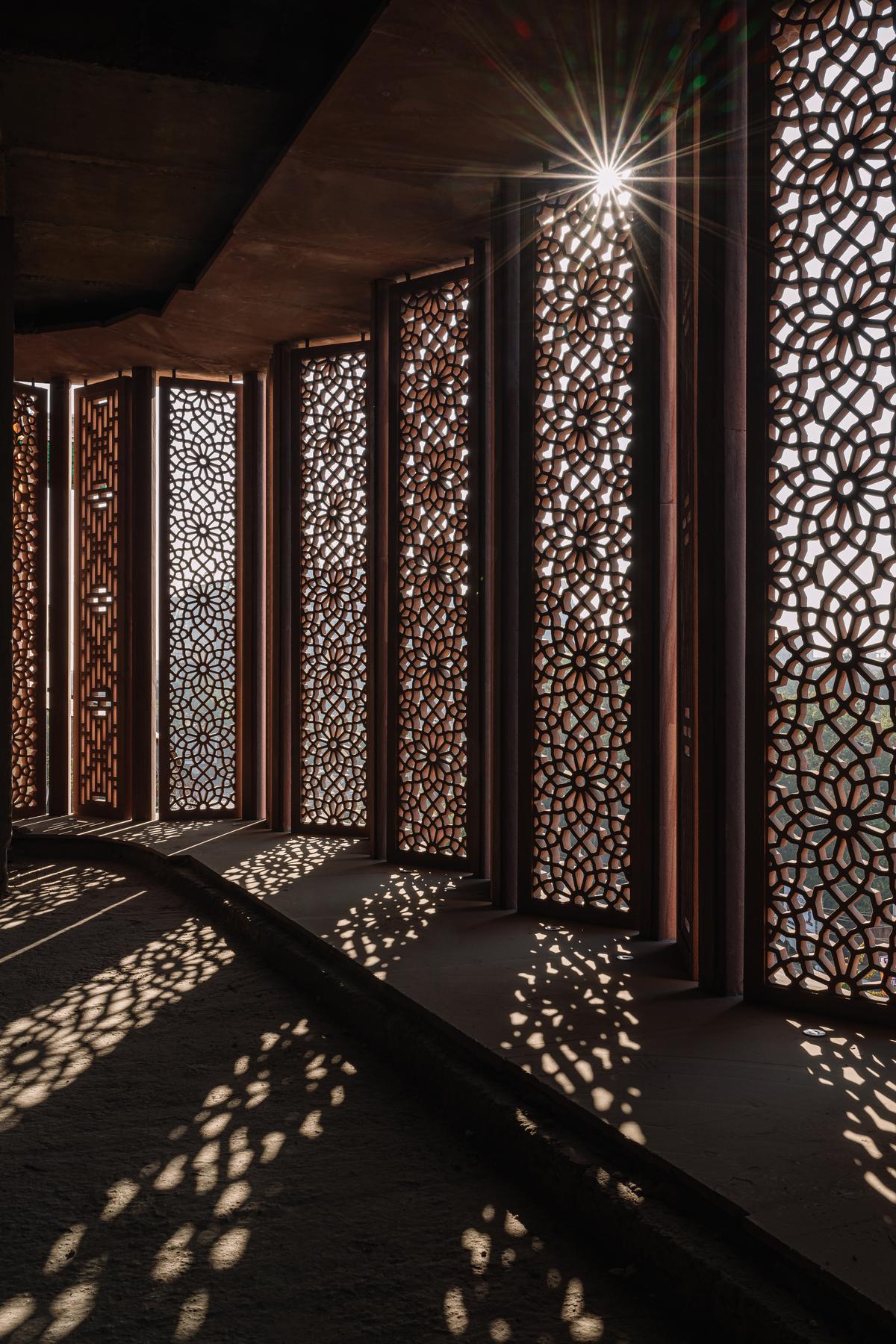
Jaali work at the Museum of Meenakari Heritage
Since it opened, the museum has been hailed for proudly staking claim to an Indian craft that denotes luxury. And in its design, it also signals a rising trend in commercial and public architecture, where traditional craft meets contemporary design in new and exciting ways.
Return of swadeshi architecture
This is remarkable considering the history of crafts in India — crafts that are as diverse in material and expression as the regions to which they belong. “Before 1850, there was a burst of creative output,” explains Siddhartha Das, an artist, curator and designer who has worked with craft communities for over 20 years. “There were lots of princely kingdoms with an incredible amount of individualism, and a great fervour for making.” As the British took over, a lot of these forms of making either died out or mutated to meet the needs and desires of a distant market. Post-Independence, he says, there was a different kind of fervour — for khadi and swadeshi, driven by a very specific sense of euphoria and purpose to build something new.
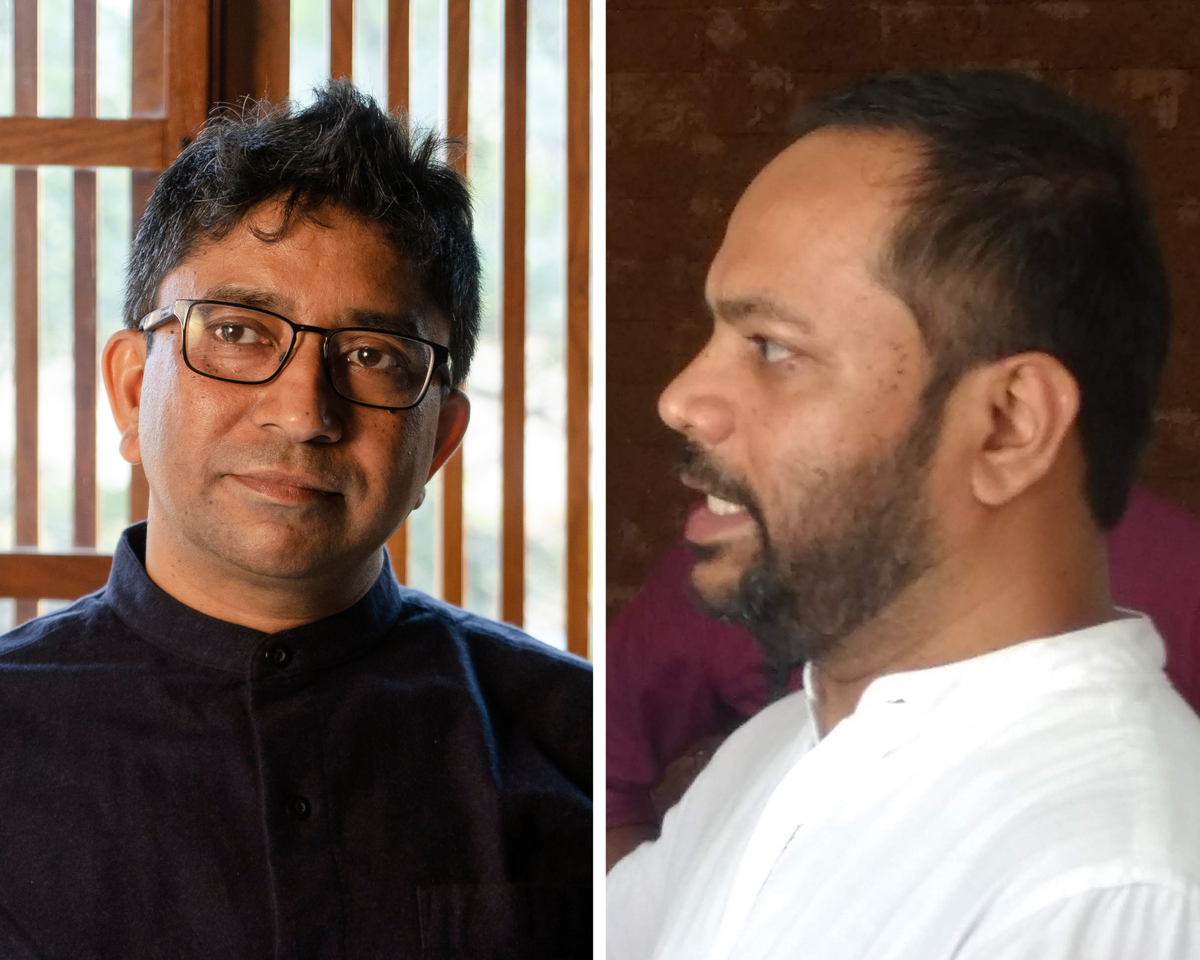
Abin Chaudhuri (left) and Sibanand Bhol
In those decades, legendary architects such as Charles Correa (Jawahar Kala Kendra, Jaipur), B.V. Doshi (JD Centre of Art, Ahmedabad), Nimish Patel and Parul Zaveri of Abhikram (The Oberoi Udaivilas, Udaipur), and Vasant and Revathi Kamath (Museum of Tribal Heritage, Bhopal), among others, tapped into India’s abundant and diverse craft-based resources and knowledge to create buildings that were at once contextual, rooted in the vernacular, and sustainable.
It is a practice that has somewhat waned in the 21st century, says Mumbai-based architect Sanjay Puri. As designers and clients looked to the West for inspiration, and aspired to sketch cityscapes strung with glass skyscrapers, this search for a new idiom took a backseat. But working with craft communities is “becoming a priority again now”, he says, especially for site-specific architecture. The last few years have seen several examples across the country, from the new Parliament building, with its jaalis and red sandstone cladding, to Bengaluru’s Kempegowda Terminal 2, which has used bamboo and traditional rattan weaving to great effect.

Sanjay Puri
Give them respect
“Many of my buildings have woodwork, for which I use local craftsmen from Kerala and Tamil Nadu. What matters is that we give them consistent work, not just a handful of projects, and the status of them doing artists’ work,” says Chennai architect Benny Kuriakose. “During the initial years of Chennai’s DakshinaChitra [the heritage museum with over 18 authentic historical houses], visitors would come with their grandchildren to show them how they used to live back in the day. Now, more than 27 years later, we have people borrowing inspiration from these houses and introducing verandahs and terracotta structures to their own buildings. We have just transplanted a 300-year-old building from Coorg at the museum and you will see a lot of woodwork in it. When we began using Athangudi tiles in our projects there were only three to four people who could make them in Karaikudi. Now, there are over 300. Traditional crafts like lime plastering are getting popular, even if the labour costs five times more than conventional plaster. It takes research to bring down costs, and it will help if our scientific institutions do some studies on this.”
Why is craft largely missing in the public sector?
Recently, in the Nokha district of Rajasthan, Puri convinced his clients to expand their vision for a memorial for the family patriarch into something that serves the community. While for their home, he integrated crafts including meenakari, miniature painting, lime plastering, marble carving and tile laying, for the accompanying open-access community centre, his firm employed local craftspeople and materials from the 114 villages of the district (such as sandstone and its carvers), to line the corridors and the facade of the building. “We had forward-thinking clients, but it’s not necessarily a spike in demand,” shares Puri, when asked if there is a greater call to integrate craft in their briefs. A majority of these requests come from the private sector, as government involvement in this field is fairly low at present.
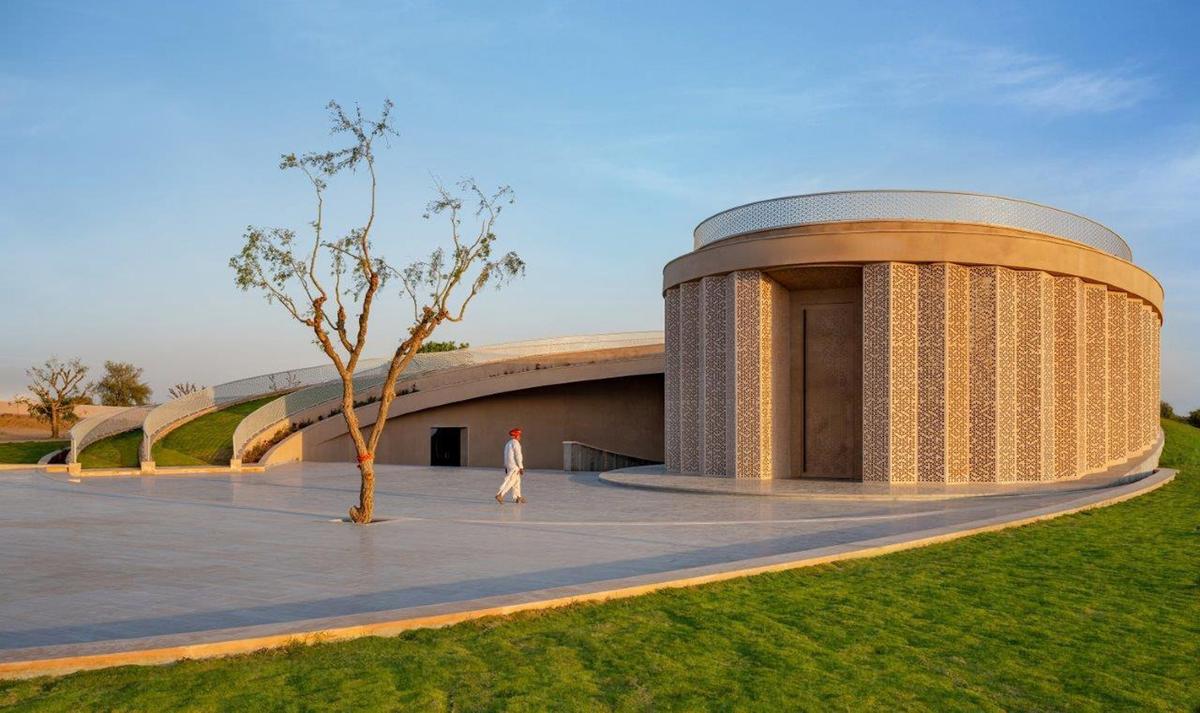
Nokha Village Community Centre
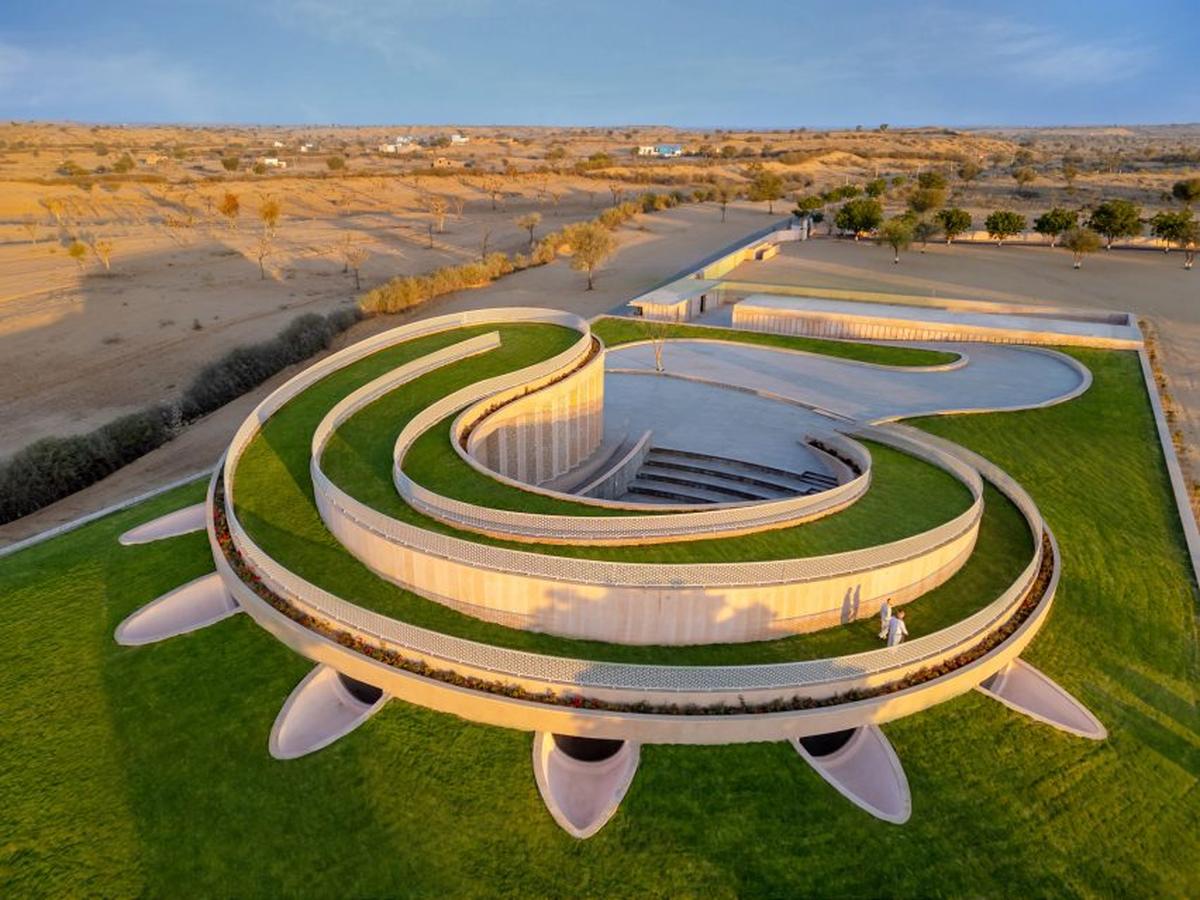
Aerial view of the community centre
It’s not a lack of opportunity that stopping the public sector from adopting craft, either. “There is plenty of scope for craft in public spaces. For instance, in railway stations. But what have we done? We have FRP murals instead of stonework. Somewhere, there is a lapse in understanding in the people involved,” says Bhol. Lack of time is another deterrent. “Iconic public buildings using craft are fewer in number today because we are constructing at a much faster pace. Everything has a short deadline, so the engagement is not there. If the government could develop a framework or an SOP for engaging with craftspeople, with terms and conditions that reflect the true on-ground realities, that will help.”
“All government projects are supposed to spend 10% of their budget on art and craft — to be context specific, using local resources. But to achieve this, you have to spend time right from the beginning ideating and researching. Very few do this. Today, the need is for more reliable interfaces between craftspeople and architects [like Collective Crafts] who can help bring craft into the built form. ”Tanuja Kanvinde Architect
At the moment, as Puri puts it, “it’s designers and architects who’ve become more aware of the need to work with crafts”. Moving away from western ideas of building, he feels a new understanding is taking shape, especially in the private sector, but that “it’s also a bit of a chain reaction”.
Encouraging community engagement
For Kolkata-based architect Abin Chaudhuri, the ongoing shift “acknowledges craft’s potential, revitalising tradition and deepening connections to India’s heritage”. Case in point: his recent project, Gallery House — a community centre that would serve the neighbourhood with a multi-purpose room, a sitting area and a pantry for tuition classes and yoga sessions — in the small West Bengal town of Bansberia.
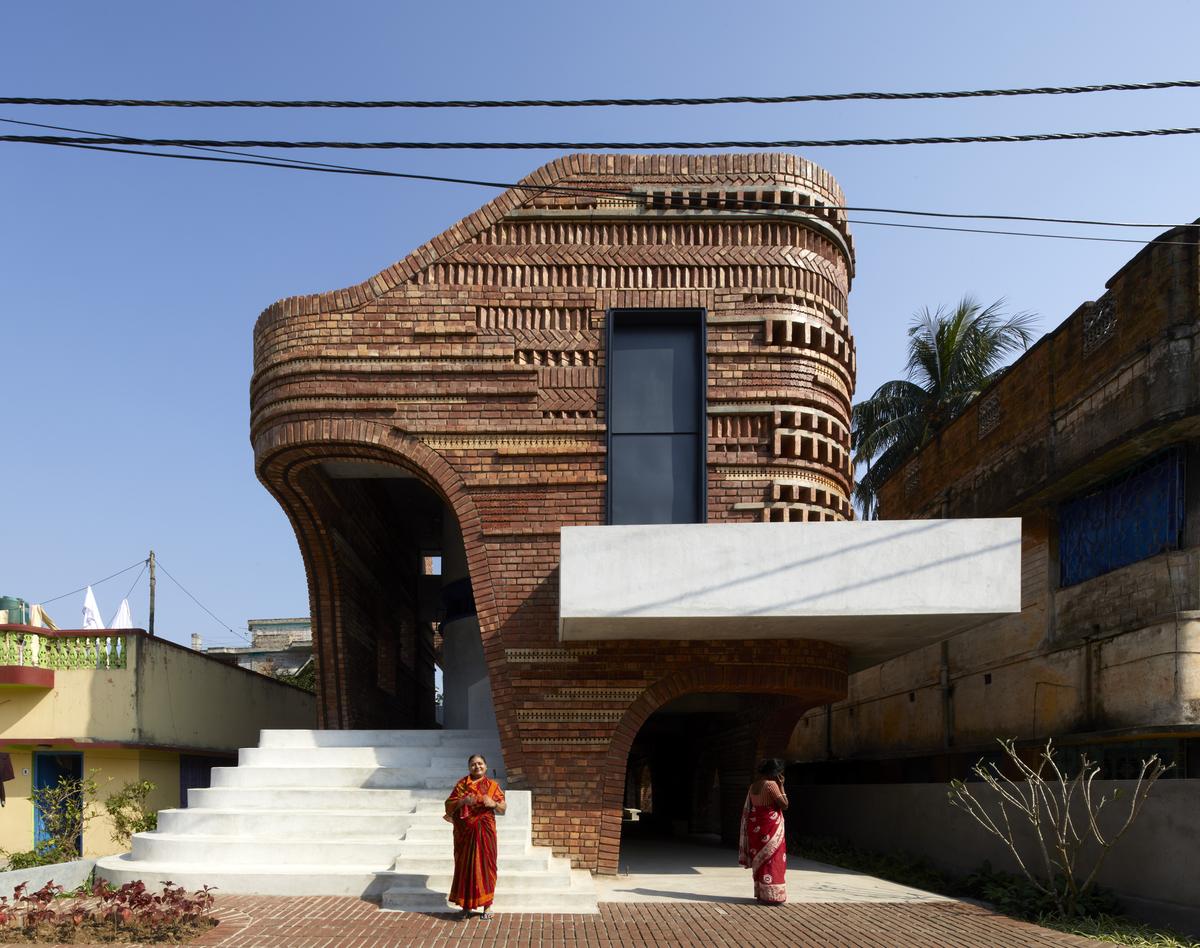
Gallery House
To reflect a sense of ownership, Chaudhuri took cues from Bengal’s terracotta temples and worked with ceramic artist Partha Dasgupta. They combined rejected ceramic blocks produced for industrial use, and terracotta bricks procured from a riverside brick field nearby, for the walls and facade of the building. Local brickwork artisans were also roped in for the Bandhan Residential School of Business in Bolpur — for whose design, Chaudhuri was keen to borrow from and showcase the context in which the campus sits. “Craft, as both material and process, is a potent tool for encouraging community engagement and sustainable practices in making.”
Across the country, hotels, retail shopfronts and airports have been canvases for showcasing India’s artisanal expertise, too. Das helped kalamkari artisans create stunning vermilion coloured textile ceilings for the Lotus House at the Bengaluru airport. For menswear designer Rajesh Pratap Singh’s flagship store in Delhi, Studio Lotus employed artisans to create a white metal mesh of scissors and loops, which stands on a grey sandstone floor textured using shot blasting and brushing techniques. And for French luxury brand Hermes’ new store at the Jio World Plaza, Mumbai, Vikram worked with 50-60 female chikankari embroiderers from Lucknow for over six months to create a 2,200 sq ft of embroidery for the walls.
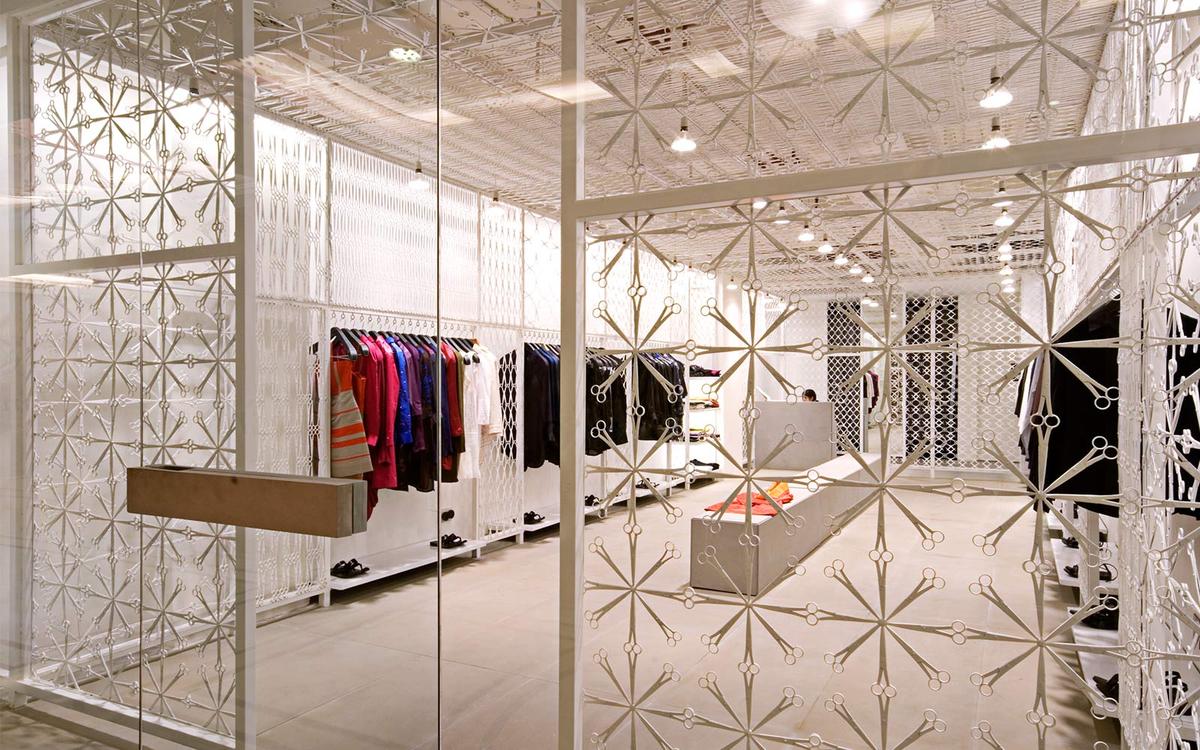
White metal mesh at Rajesh Pratap Singh’s flagship store
IIT Bhilai’s new campus is another example of how traditional craft and contemporary architecture can be in sync. Delhi architects Sanjay and Tanuja Kanvinde hired Bhol of Collective Crafts to create an environment in a technology institution that evoked culture, nature and local mythology. He worked with wrought iron craftsmen to translate Gond artist Ram Singh Urveti’s drawings — telling stories like the birth of the river Narmada, the forest as a fount of nourishment — into eye-catching metal panels.
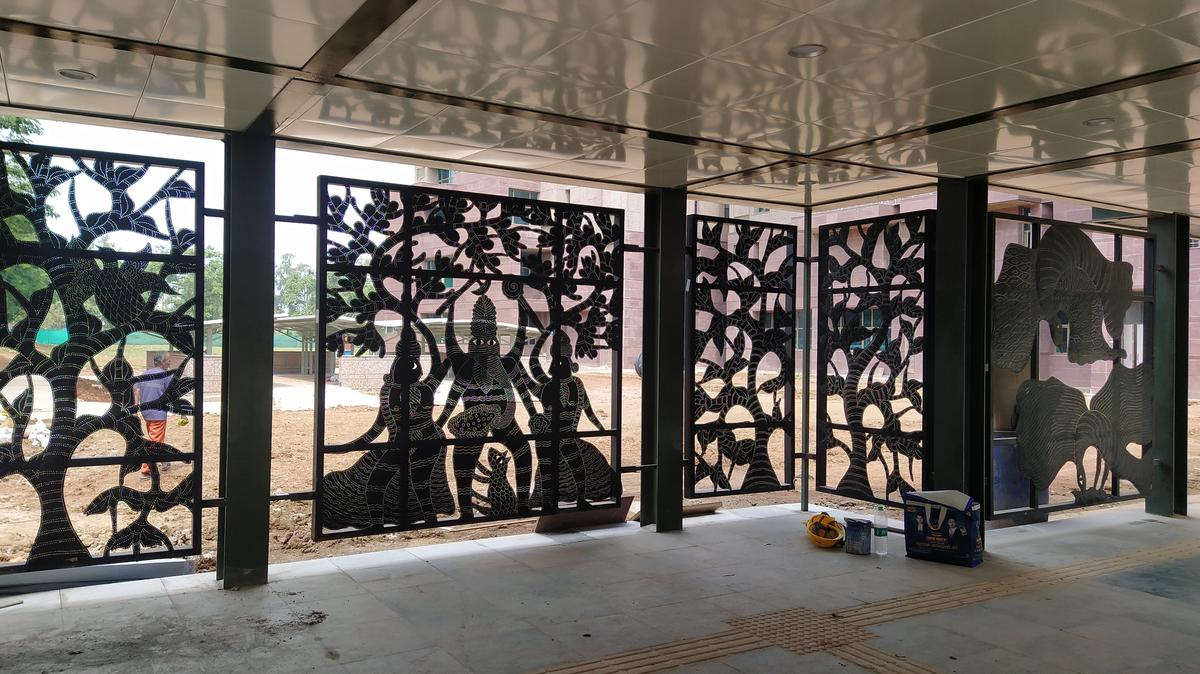
IIT Bhilai’s wrought iron panels that translated Gond artist Ram Singh Urveti’s drawings
Other side of the picture
“What we need today is an intervention with craft,” says Vinu Daniel, a climate-responsive architect from Kerala who uses local knowledge and resources in his builds. “I don’t believe in craft continuing the way it has for thousands of years. We need architects and builders to learn about these crafts, and research, tweak, and adapt them so that they can be used for another 1,000 years.”
Daniel also feels that monopolising craft knowledge is hastening its death. “For instance, Rohtak domes, a brick roofing technique from Haryana, is a very popular now. It is still practised by a mason and his four brothers, who have updated the process to meet 21st century needs, but won’t share their skills. Though they are being employed by a lot of architects, the craft will die out.”
Instead of working exclusively with artisans, his team also learns the techniques so that they can research and adapt them. “Currently, I’m building a bridge house [a closed bridge that can serve as a house] in Karjat, Maharashtra. We are constructing the roof from thatched grass, a technique that is almost dead today. An old Maharashtrian man — partially blind, but who can still distinguish between different grasses — is imparting his knowledge to us and we are tweaking it.” He is reinforcing the grass with a new type of waterproofing and giving it a layer of ferrocement to ensure longevity and no leakages. “The biggest threat of crafts is their own puritanism” and this needs to change.
Incentivising the crafts sector
Over two decades of doing this, Bhol is well-versed with the challenges that come with integrating craft in contemporary architecture. “We’ve realised that senior craftsmen often come with a lot of rigidity. It’s the young artisans who want answers. ‘When everybody is rejecting this traditional craft, where do we fit in?’ they ask. Our challenge has been to take them along and demonstrate that their work can also be contemporary, meaningful and vastly different from what they’ve understood it to be.”
Worryingly, “today, craft is the fourth largest employing sector in the country, and it has the highest attrition rate after agriculture,” says Das. Still, they all agree that when done right, craft in contemporary architecture can be tremendously rewarding, especially for the craftspeople. “Employing artisans from craft communities [in projects like IIT Bhilai] is important because it not only honours their expertise, gives them a livelihood and different ways of looking at what they did traditionally,” adds Tanuja, explaining that bringing them on board isn’t a budget challenge either. “The base material being used is still the same. And with the labour cost, you are able to provide somebody a living.” Vikram has witnessed lives changed, artisans who’ve been able to swap their tin roof houses for pucca ones. Choksi mentions a craft community that worked with Studio Lotus on the Raas Hotel in Jodhpur in 2013 — casting terrazzo floors — who are now so overworked, they are turning away commissions.
“The primary challenge is a lack of awareness about traditional crafts on the architect’s side. The reason for this is that our education system does not focus on it at all. There is a treasure trove right in our backyard, yet most architects are likely to choose a Scandinavian aesthetic. A long term solution has to be at the policy level, by introducing crafts in the curriculum itself.”Nisha VikramFounder, CraftCanvas
Nisha Vikram
They all also mention the desire for more government incentive in this domain. Jaipur-based painter Nimbark is critical of the PM Vishwakarma Yojana, a ₹13,000 crore scheme announced last September to cover 18 handicrafts and artisans across India. “Miniature painting and many others aren’t on the list. Colleges don’t teach it anymore, and people now make art on computers. We need all the support we can get,” he says. “If projects like these museums can be encouraged, if the government could mandate that a corner for Indian crafts be reserved in all new buildings — that will be a start.”
Judging by Instagram reels that show off paintings, Chandigarh style chairs and rugs under hashtags like “Indian modern”, maybe that day is not far away. “What we are realising is that the world is becoming an increasingly homogenous place,” observes Choksi. “This idea of everything looking identical, whether I’m sitting in Mumbai or New York, is not speaking to everyone anymore. Craft is contextual to our country because we have a lot of it, and we have access to it. It’s something that elevates our everyday experience. Why not infuse it?”
[ad_2]





